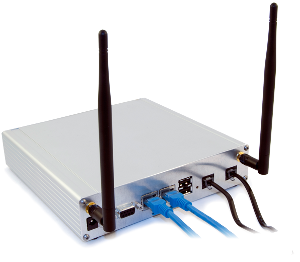ADSL and Fibre Broadband Line Bonding
 Bonded ADSL is where multiple broadband lines are joined together to form a single larger pipe.
Bonded ADSL is where multiple broadband lines are joined together to form a single larger pipe.
Bonding is not the same as load balancing, which would require a complicated algorithm to keep the lines in balance. A bonded connection operates as one pipe and the data going down that pipe is automatically shared proportionately over the individual ADSL lines.
Mature technology
The industry standard way of achieving this is through the use of MultiLink PPP (ML-PPP). This is a tried and tested technology and has been used by Internet Service Providers for many years. It is the very same technology used to provide ISDN internet connections larger than 64k.
Whereas with ISDN multiple 64k channels could be combined to make a larger (128k or 256k) connection, with DSL we are combining multiple high-speed ADSL or SDSL lines.
Special requirements for bonding ADSL lines
ADSL lines have certain properties that pose particular challenges to when it comes to bonding. Unlike ISDN lines, ADSL lines do not have guaranteed or even predictable levels of bandwidth. Different ADSL lines at the same site can also have varying latency. Naive bonding implementation that do not take account of these factors will be problematic and will provide a poor quality bonded connection. At Netservers we use an enhanced form of MultiLink PPP called "Quantum Bonding". This technology is been created specifically to address the unique challenges of DSL line bonding and is the foundation of our ADSL bonding service.
 Required Equipment
Required Equipment
Ordinary consumer ADSL routers are not capable of bonding ADSL lines. A more sophisticated router such as Cisco or FireRack is required to perform line bonding.
The FireRack equipment supplied by Netservers is available with 2, 4, 6 and 8 ADSL 2+ interfaces. Cisco routers that take WIC modules can be similarly configured by adding the appropriate number of ADSL2+ WIC cards.
The technique used by Netservers is true bonding of PPPoE or PPPoA DSL connections. Some Virtual Internet Service Providers (VISPs) claim to provide a bonded ADSL service without utilising ML-PPP. Typically the technique that they use is to bond multiple VPN connections together, rather than bonding multiple DSL lines. This is not true line bonding and is a technically inferior solution with a number of disadvantages.
Increased resilience through ADSL bonding
The most obvious benefit of ADSL line bonding is the increase in download and upload bandwidth. Less obvious is increased fault-tolerance and resilience that that bonding provides. The bonding service provided by Netservers will utilise however many lines are available at a given time. If for instance you have a four-line bonded service, and one of those lines fails, your service will continue to operate over the three remaining lines. Naturally you will see a reduction in available bandwidth, but the service as a whole will continue to operate.
| Attachment | Size |
|---|---|
| 2.31 MB |
